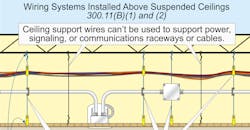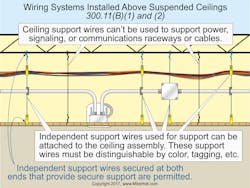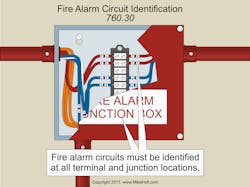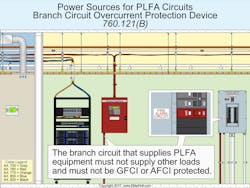Article 760 covers the installation of wiring and equipment for fire alarm systems, including circuits controlled and powered by the fire alarm. Those circuits are for such things as fire detection and alarm notification, guard’s tour, sprinkler water flow, and sprinkler supervisory systems. NFPA 72, National Fire Alarm Code, provides the requirements for the selection, installation, performance, use, testing, and maintenance of these systems.
Building control circuits associated with the fire alarm system, such as elevator capture and fan shutdown, must comply with Art. 725 [760.3(E)]. Article 760 applies if these components are powered and directly controlled by the fire alarm system.
Unlimited versus limited power source
Correct application of Art. 760 requires understanding the difference between a non-power-limited fire alarm (NPLFA) circuit and a power-limited fire alarm (PLFA) circuit.
• NPLFA circuits can operate at up to 600V, and the power output isn’t limited [Sec. 760.41 and Sec. 760.43].
• NPLFA circuits must comply with Parts I and II of Art. 760 [Sec. 760.35(A)].
• A PLFA circuit must have the voltage and power limited by a listed power supply that complies with Sec. 760.121.
• PLFA circuits must comply with Parts I and III of Art. 760 [Sec. 760.35(B)].
Access to electrical equipment behind panels
Access to equipment can’t be blocked by a cabling accumulation that prevents the removal of suspended-ceiling panels so route and support your cables in a way that allows suspended-ceiling panels to be moved for access to electrical equipment [Sec. 760.21].
Mechanical execution
Fire alarm circuits must be done in a neat and workmanlike manner [Sec. 760.24(A)].
This includes supporting:
• Exposed cables by the building’s structural components so the cable won’t be damaged by normal use.
• Cables by straps, staples, hangers, cable ties, or similar fittings designed and installed in a manner that won’t damage the cable.
• Raceways/cables above a suspended ceiling by independent support wires attached to that ceiling [Sec. 300.11(B), Sec. 760.46, and Sec. 760.130] (Fig. 1).
Cables installed through (or parallel to) framing members or furring strips must be protected where they’re likely to be penetrated by nails or screws. Do this by installing the wiring method so it’s at least 1¼ in. from the nearest edge of the framing member or furring strips, or by protecting them with a 1⁄16-in.-thick steel plate or the equivalent [Sec. 300.4(D)].
Abandoned cable
To limit the spread of fire or products of combustion within a building, the accessible portion of cable not terminated at equipment and not identified for future use with a tag must be removed [Sec. 760.2].
Tags identifying cables for future use must be able to withstand the environment involved.
Circuit identification
Fire alarm circuits must be identified at terminal and junction locations. The identification must be done in a manner that helps prevent unintentional signals on the fire alarm system circuits during testing and servicing of other systems [Sec. 760.30] (Fig. 2).
Red raceways and fittings are sometimes used, but the red color isn’t an NEC requirement.
Beyond a building
If fire alarm circuit conductors extend beyond a building and run outdoors, they must be installed per Parts II, III, and IV of Art. 800, and Part I of Art. 300 [Sec. 760.32].
PLFA circuits
PLFA equipment must be supplied by a branch circuit that supplies no other load and isn’t GFCI or AFCI protected [Sec. 760.121(B)] (Fig. 3).
The location of the branch-circuit overcurrent protection device for the PLFA equipment must be permanently identified at the fire alarm control unit. The branch-circuit overcurrent protection device must be identified in red, accessible only to qualified personnel, and identified as “FIRE ALARM CIRCUIT.” The red identification must not damage the overcurrent protective device or obscure any manufacturer’s markings.
Fire alarm equipment supplying PLFA cable circuits must be durably marked to indicate each circuit that’s a PLFA circuit [Sec. 760.124]. Fire alarm circuits must be marked at terminal and junction locations [Sec. 760.30].
PLFA cables can’t be strapped, taped, or attached to the exterior of any raceway as a means of support [Sec. 760.143]. PLFA conductors and cables described in Sec. 760.179 must be installed as detailed in Sec. 760.130(B).
Two key points:
1. Cable splices or terminations must be made in listed fittings, boxes, enclosures, fire alarm devices, or utilization equipment.
2. PLFA cable installed exposed must be adequately supported and protected against physical damage.
Installing PLFA cables in buildings
Installations of PLFA cables in buildings must comply with Sec. 760.135(A) through (J).
(A) PLFA cables installed in buildings must be listed.
(B) A plenum-rated PLFA cable may be installed within ductwork specifically fabricated for environmental air spaces per Sec. 300.22(B) if the cable is directly associated with the air distribution system and complies with (1) and (2):
(1) The cable is plenum-rated with a length as short as practical to perform the required function.
(2) The cable is nonplenum-rated within a raceway per Sec. 300.22(B).
(C) Plenum rated FPLP cables are permitted in plenum spaces as described in Sec. 300.22(C).
(H) The following cables may be installed in building locations other than those covered in Sec. 770.113(B) through (H):
(1) Types FPLP, FPLR, and FPL cables
(2) Types FPLP, FPLR, and FPL cables installed in:
a. Plenum communications raceways
b. Plenum cable routing assemblies
c. Riser communications raceways
d. Riser cable routing assemblies
e. General-purpose communications raceways
f. General-purpose cable routing assemblies
(3) Types FPLP, FPLR, and FPL cables installed within a raceway of a type recognized in Chapter 3.
Separate PLFA from power conductors
PLFA conductors can’t be placed in any enclosure, raceway, or cable with conductors of electric light, power, or Class 1 circuits [Sec. 760.136(A)]. But there are circumstances in which this is permitted [Sec. 760.136(B) through (G)]. For example:
• If separated by a barrier, PLFA circuits can be installed with electric power conductors [Sec. 760.136(B)].
• Where these other conductors are introduced solely for connection to the same equipment, and a minimum of ¼ in. separation is maintained from the PLFA cable conductors, PLFA conductors can be installed with them [Sec. 760.136(D)].
Class 2, Class 3, and communications circuits
PLFA circuits, communications circuits, or Class 3 circuits can be in the same cable, enclosure, cable tray, raceway, or cable routing assembly [Sec. 760.139(A)].
Class 2 circuits can be within the same cable, cable routing assembly, enclosure, cable tray, or raceway as conductors of PLFA circuits if the Class 2 circuit conductor insulation isn’t less than that required for the PLFA circuits [Sec. 760.139(B)].
Audio system circuits [Sec. 640.9(C)] using Class 2 or Class 3 wiring methods [Sec. 725.133 and Sec. 725.154] can’t be installed in the same cable, cable routing assembly, cable tray, or raceway with PLFA conductors or cables [Sec. 760.139(D)].
This rule exists because a fault from audio amplifier circuits to fire alarm circuits could disrupt the operation of fire alarm systems. This rule doesn’t apply to the voice annunciation audio circuits supplied and controlled from a fire alarm panel.
Application, listing, and marking of PLFA cables
PLFA cables must meet the requirements of Table 760.154, or the substitutions allowed in Sec. 760.154(A).
PLFA cables installed as wiring within buildings must be listed as being resistant to the spread of fire and other criteria per Sec. 760.179(A) through (H) and be marked per Sec. 760.179(I) [Sec. 760.179].
Cable used in a wet location must be listed for use in wet locations or have a moisture-impervious metal sheath.
Fire alarm cable must have a voltage rating of at least 300V and (new with the 2017 NEC) a temperature rating of at least 60˚C [Sec. 760.179(C)].
Type FPLP plenum cable must be listed as being suitable for use in a plenum space [Sec. 760.179(D)].
Cables must be marked per Table 760.179(I). Voltage ratings can’t be marked on the cable [Sec. 760.179(I)]. Voltage markings on cables may suggest that the cables are suitable for Class 1 or electric power and light applications, which they aren’t.
Avoiding errors
Make a point of understanding how the general requirements (Part I) will apply to your specific application. Before working with a given alarm circuit, determine whether that circuit is non-power limited (NPLFA) or power-limited (PLFA). If it’s NPLFA, follow Part II. If it’s PLFA, carefully review Table 760.154 so you can select the correct type of cabling for the application.
Holt is the owner of Mike Holt Enterprises, Inc. in Leesburg, Fla. He can be reached at www.mikeholt.com.About the Author

Mike Holt
Mike Holt is the owner of Mike Holt Enterprises (www.MikeHolt.com), one of the largest electrical publishers in the United States. He earned a master's degree in the Business Administration Program (MBA) from the University of Miami. He earned his reputation as a National Electrical Code (NEC) expert by working his way up through the electrical trade. Formally a construction editor for two different trade publications, Mike started his career as an apprentice electrician and eventually became a master electrician, an electrical inspector, a contractor, and an educator. Mike has taught more than 1,000 classes on 30 different electrical-related subjects — ranging from alarm installations to exam preparation and voltage drop calculations. He continues to produce seminars, videos, books, and online training for the trade as well as contribute monthly Code content to EC&M magazine.




